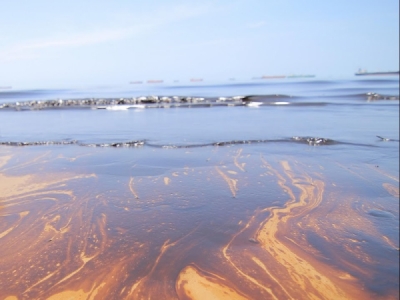
Posted on September 1, 2020
Wall St Journal, By Eric Sylvers and Sarah McFarlane
AUG 31, 2020 – Recent oil spills in Russia and Mauritius have shown that the industry still needs better methods for cleaning up accidents. Researchers are working on some unlikely-sounding solutions, including oil-absorbing wood chips, a solar-powered robot and a reusable sponge.
The oil industry is controlled by large companies and their suppliers, which together have often been the cause of spills, but university researchers and small firms are playing a key role in promoting new ways to clean up.
Researchers at Northwestern University have developed a reusable sponge coated in a mixture containing iron and carbon that can absorb 30 times its weight in oil. The sponge, similar to sponges in everyday items such as furniture cushions and packaging, has attracted interest for further testing from Several major oil companies, according to the researchers.
The number of spills has declined in recent years. There were only three from tankers exceeding seven metric tons last year, the lowest since the International Tanker Owners Pollution Federation Ltd began collecting data in 1970. But 1,000 metric tons of oil still made its way into the environment from tankers in 2019.
Regulations in many countries have helped reduce spills. The 1990 Oil Pollution Act proved a turning point in the U.S., introducing changes including in-creased penalties and requirements for vessel construction, says Dana Tulis, the director of emergency management for the U.S. Coast Guard. The act came the year after Exxon Corp.’s Valdez tanker hit a reef off the coast of Alaska, causing the second-largest spill in U.S. waters, trailing only BP PLC’s Deepwater Horizon well blowout in 2010 in the Gulf of Mexico.
Research on finding better ways to clean up oil spills accelerated after the Deepwater Horizon disaster. But the spotty response to the spills in Russia’s Arctic region, where fuel from a power station contaminated a swath of land and several bodies of water in June, and in Mauritius, where last month a ship ran aground against a coral reef, showed cleanup methods in many cases have advanced little.
Some progress has been made through the use of satellite images and remote sensors on drones, but traditional methods that have limitations, and that often cause their own Environmental damage, still dominate.
Booms can corral oil, but don’t work in rough seas or after the oil has dispersed widely. Skim-ming the oil off the surface of the sea usually only works after booms have been successfully deployed. Burning the oil or breaking it down with chemicals can damage marine life, and the smoke from burning causes air pollution. Plastics that absorb the oil must be disposed and contribute to landfills.
“We have not invented the magic wand yet, we still have to deal with the environment and physics of oil dispersion,” said John Tarpley, regional operations branch chief in the Emergency Response Division of the National Oceanic and Atmospheric Administration.
Researchers at Dresden Technical University and Leipzig University in Germany have developed a cleanup protocol using oil-absorbing wood chips that are dumped into the sea by plane, helicopter or ship following an oil spill. The wood chips can be recovered—which sets them apart from most existing solvents—and if that is impossible because of bad weather, they biodegrade in the water.
The wood chips can work in shallow water or in bad weather, situations when many standard methods are ineffective. They could have been used in the Mauritius spill, which was close to land and where cleanup efforts were hampered by poor weather conditions, but they need to be in place beforehand, and locals need to be trained on how to deploy them, said Holger Unbehaun, a scientist at Dresden Technical University who developed the wood chips.
The wood chips are in place and ready to be used if there is a spill in the Baltic Sea off Germany’s northern coast. They have worked in laboratory and field tests, but haven’t been used in an emergency yet. The coronavirus pandemic has stymied efforts to deploy the wood chips to other areas.
“There have been no spills in the past few years in the Baltic Sea, which we are happy about, but it also means we haven’t been able to test in a real oil spill,” said Mr. Unbehaun.
Tejas Kabra, a 24-year-old graduate student at North Carolina State University, developed a floating solar-powered robot filled with nanoparticles made from tree leaves that separate oil from water. Once the robot is filled up with oil, which can be reused, it returns to its base. Mr. Kabra devel-oped the robot while he was an undergraduate in India. It can be deployed where there has been a spill, or it can roam freely looking for oil to suck up.
“My first goal is to finish my master’s degree and then I want to bring the robot to market,” said Mr. Kabra.
Following the blowout of the Deepwater Horizon well, which gushed oil for three months before it could be capped, eight of the world’s largest oil companies, including BP, Exxon Mobil and Chevron Corp., commissioned Italian oil services company Saipem SpA to come up with a plugging mechanism that can be sent rapidly around the world.
The result is a 46-foot-high structure with four silos supporting a plugging mechanism. It can be disassembled into about 100 pieces and transported by ship or several cargo jets to where it is needed.
“After the Gulf of Mexico blowout, the industry saw how difficult it can be to cap a runaway well, and it became clear that we had to come up with a better way of dealing with this the next time it happens,” said Diego Lazzarin, an engineered products manager at a Saipem unit that worked to develop the plug.





